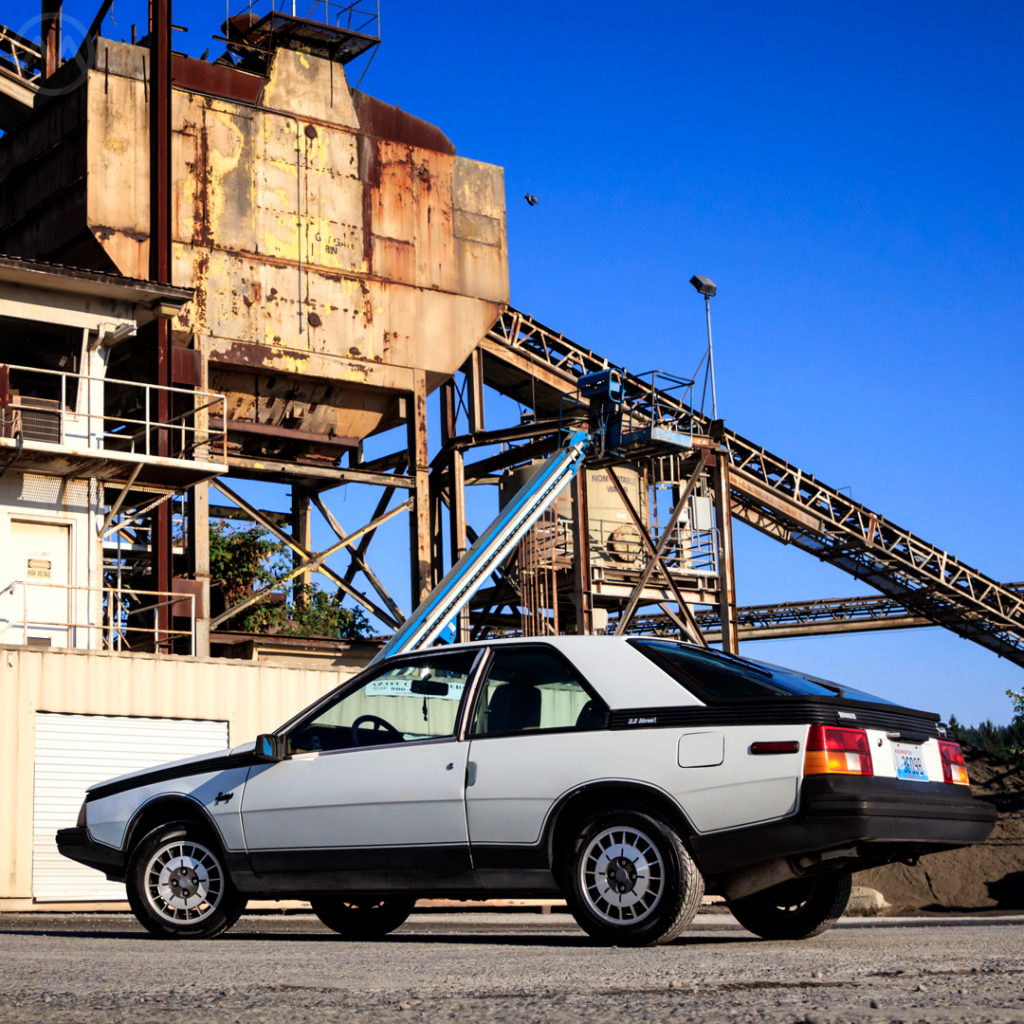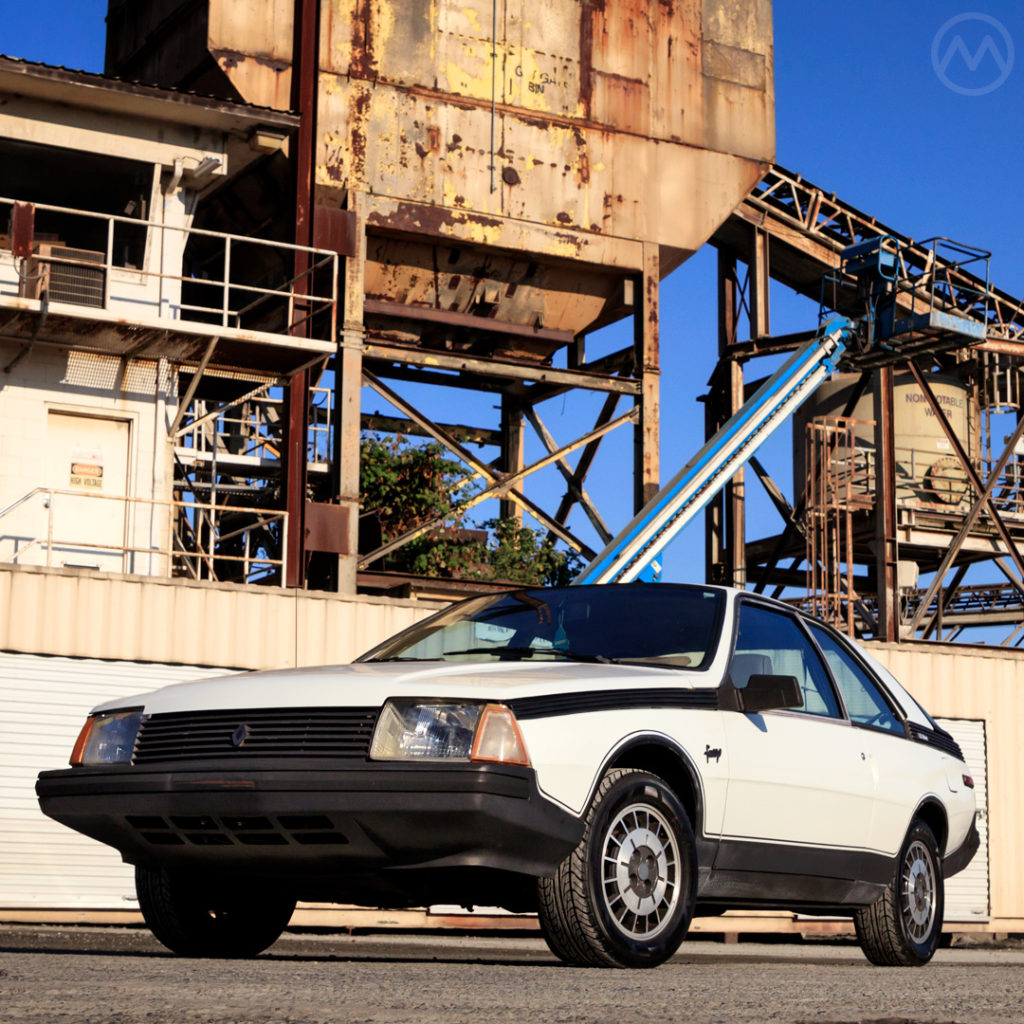The Renault Fuego was old news by 1985, and definitely *not* a success in the U.S., where survivors are very rare now, but it was a nice car to drive and had a style all its own.
The late U.S. cars, with the 2.2L J7T “Douvrin” engine were some of the nicest, though they lacked some features of the Euro models, and they came with recessed sealed-beam lamps (substituted here for Euro-spec units) and big bumpers.
The Fuego was well-liked in Europe and South America (particularly in Argentina and Venezuela), but distinctly an also-ran in the U.S., where its fate was tied AMC’s dealer network and Americans often unhappy view of Renault’s quality control.
Fuego Replaces R15/R17
The Fuego, oddly a car with a name rather than a number as standard practice at Renault, was a direct replacement for the R12-based 15/17 coupes of the 1970s.
Originally, plans were a little more ambitious for the car – but economics dictated that it be based the circa-1978 R18 (sold in the U.S. as the 18i), just as its predecessors were based on the R12.
The basic structure of the front-drive 18 was used underneath, with a front suspension derived from the larger R20/30. Renault’s styling department was led by ex-Citroën chief stylist Robert Opron, but the Fuego was designed primarily by one of his staffers – Michel Jardin.
Jardin also penned a proposal for a five-door Fuego, which looked quite a bit like the later R25, a stylistically related car. The interior, comfy but not radical, was by Francois Lampreia.
It was comprehensively wind-tunnel tested, which made it a particularly aerodynamic car when it debuted in 1980 – with a cd of just .32 in an era when it competed against coupes like the Ford Capri II.

Europeans immediately liked the stylish, futuristic Fuego, with its unusual plastic cladding and sleek shape, though it was mostly style over speed early on.
The Fuego wasn’t as fast as a Capri, but was Europe’s best-selling coupe from 1980-82. More speed came later, with a 1.6L Turbo and a 2.0, plus a 2.1L turbodiesel, rare in a coupe then (only Isuzu was offering something similar).
Many of the Fuego’s most innovative features were confined to the European market – namely the introduction of remote locking and a steering wheel with audio controls – stuff we take for granted today. The Fuego was the first car with a remote lock “PLIP,” named for its inventor, Paul Lipschutz.
Fuego in the USA
In the USA, the Fuego arrived in the spring of 1982 as a 1.6L N/A or Turbo. Buyers either loved or hated the shape but the press liked the car – unfortunately initial quality was spotty, which didn’t help Renault’s already rocky rep with Americans.
It replaced the aging AMC Spirit at AMC stores, though there was some small overlap.
Renault’s gradual takeover of AMC set it up with a solid distribution network, but not every AMC dealer really wanted to sell the French Renaults (or deal with their quirks); and some were discouraged by the poor initial quality of some of the cars – they could be fantastic or terrible, which was frustrating in a car that drove well and looked exotic.
In 1983, production began of Renault’s domestically-produced Alliances, which soon accounted for the vast majority of car sales at AMC dealers, with the French Renaults fading after some initial excitement about the 18i (in 1981) and Fuego.
The U.S.-only 2.2L was added in 1984 – with ~110hp it was as fast or faster than the Turbo 1.6, and simpler too. The Turbo was dropped for 1985 but by then the Feugo was heavily incentivized to help move stock. Just ~7,200 French-made Renaults were sold in the U.S. in 1985, split between the Fuego and the last remaining 18i – now called the SportWagon.
Renault’s rapid U.S. decline and eventual departure left many Fuegos without proper support. For the first few years they were covered by AMC’s 5/50 warranty, considered lengthy at the time, but after Renault sold AMC to Chrysler, most dealers were even less interested in servicing them than before. And since most had been sold in 1982-1983, many were out of warranty by 1989. Parts supply became problematic by the 1990s.

The low values of a now-orphaned and out of style car meant few owners wanted to put money into them, further thinning the herd. But they still looked like nothing else and their driving dynamics were pretty good for a small, sedan-based front-drive coupe (though not as good as, say, a Honda Prelude).
Only die-hard American Renault-philes continued to care for these cars after the early 1990s, and this one was owned by a long-time, well-known Renault and Citroën enthusiast until last year. OldMotors is about the cars, not the author, but this particular car is now in the OldMotors stable, though it’s not quite ready to be used on a regular basis.
In Argentina, the Fuego was particularly well-loved, and remained in production – with periodic mechanical and styling updates, until 1993. It was also a popular car in Venezuela, where it was also locally built. Both countries had considerably-sized racing series for Fuegos.

